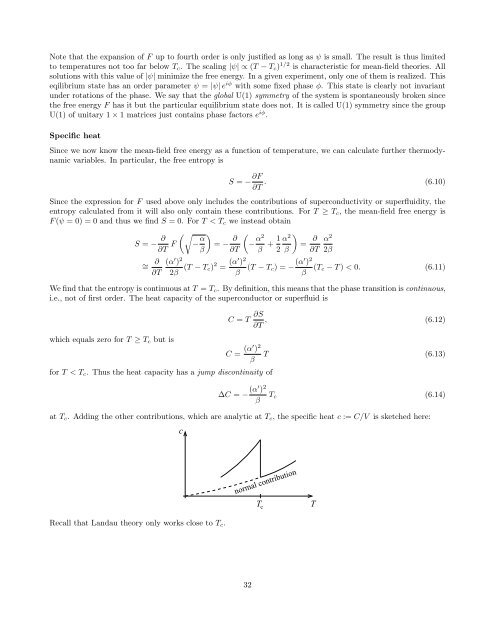Carsten Timm: Theory of superconductivity
Carsten Timm: Theory of superconductivity
Carsten Timm: Theory of superconductivity
You also want an ePaper? Increase the reach of your titles
YUMPU automatically turns print PDFs into web optimized ePapers that Google loves.
Note that the expansion <strong>of</strong> F up to fourth order is only justified as long as ψ is small. The result is thus limited<br />
to temperatures not too far below T c . The scaling |ψ| ∝ (T − T c ) 1/2 is characteristic for mean-field theories. All<br />
solutions with this value <strong>of</strong> |ψ| minimize the free energy. In a given experiment, only one <strong>of</strong> them is realized. This<br />
eqilibrium state has an order parameter ψ = |ψ| e iϕ with some fixed phase ϕ. This state is clearly not invariant<br />
under rotations <strong>of</strong> the phase. We say that the global U(1) symmetry <strong>of</strong> the system is spontaneously broken since<br />
the free energy F has it but the particular equilibrium state does not. It is called U(1) symmetry since the group<br />
U(1) <strong>of</strong> unitary 1 × 1 matrices just contains phase factors e iϕ .<br />
Specific heat<br />
Since we now know the mean-field free energy as a function <strong>of</strong> temperature, we can calculate further thermodynamic<br />
variables. In particular, the free entropy is<br />
S = − ∂F<br />
∂T . (6.10)<br />
Since the expression for F used above only includes the contributions <strong>of</strong> <strong>superconductivity</strong> or superfluidity, the<br />
entropy calculated from it will also only contain these contributions. For T ≥ T c , the mean-field free energy is<br />
F (ψ = 0) = 0 and thus we find S = 0. For T < T c we instead obtain<br />
S = − ∂ (√−<br />
∂T F α )<br />
= − ∂ (− α2<br />
β ∂T β + 1 2<br />
∼= ∂<br />
∂T<br />
(α ′ ) 2<br />
2β (T − T c) 2 = (α′ ) 2<br />
α 2 )<br />
= ∂<br />
β ∂T<br />
β (T − T c) = − (α′ ) 2<br />
α 2<br />
2β<br />
β (T c − T ) < 0. (6.11)<br />
We find that the entropy is continuous at T = T c . By definition, this means that the phase transition is continuous,<br />
i.e., not <strong>of</strong> first order. The heat capacity <strong>of</strong> the superconductor or superfluid is<br />
which equals zero for T ≥ T c but is<br />
for T < T c . Thus the heat capacity has a jump discontinuity <strong>of</strong><br />
C = T ∂S<br />
∂T , (6.12)<br />
C = (α′ ) 2<br />
β T (6.13)<br />
∆C = − (α′ ) 2<br />
β T c (6.14)<br />
at T c . Adding the other contributions, which are analytic at T c , the specific heat c := C/V is sketched here:<br />
c<br />
normal contribution<br />
T c<br />
T<br />
Recall that Landau theory only works close to T c .<br />
32

















